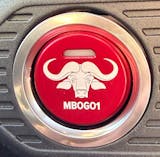What to Choose for Recovery Points: Steel or Aluminum?
When outfitting your truck for off-road adventures, choosing the right recovery points is crucial. The two main contenders are billet aluminum recovery points and steel recovery points. Each has its strengths and drawbacks, depending on your needs and priorities. Here’s a breakdown to help you decide.
Billet Aluminum Recovery Points
Advantages:
-
Lightweight: Aluminum is significantly lighter than steel, reducing the overall weight of your vehicle. This improves fuel efficiency and handling—key benefits for off-road enthusiasts.
-
Corrosion Resistance: Aluminum naturally resists rust and corrosion, even in wet or salty environments. This makes it a low-maintenance option that retains its quality over time.
-
Premium Appearance: Billet aluminum recovery points are machined with precision and often come with anodized, polished, or custom finishes. These options provide a sleek, high-end look to complement your truck.
-
Customization Options: Available in various colors, finishes, and even personalized designs, billet aluminum recovery points let you match your truck’s style while adding a unique touch.
Disadvantages:
-
Strength: While strong enough for most recovery scenarios, aluminum has lower tensile strength than steel. It’s ideal for moderate use but may not withstand extreme recovery situations.
-
Cost: The machining process and material make billet aluminum recovery points more expensive than steel options.
Steel Recovery Points
Advantages:
-
Superior Strength: Steel is known for its incredible tensile strength and durability, making it the go-to choice for heavy-duty recovery tasks.
-
Affordability: Steel recovery points are generally more budget-friendly compared to billet aluminum options.
-
Durability: Steel can handle impacts and heavy loads without bending or breaking, ensuring reliability in extreme recovery situations.
Disadvantages:
-
Weight: Steel is much heavier than aluminum, which can negatively impact your truck’s performance and fuel efficiency.
-
Corrosion Risk: Steel is prone to rust without proper coatings like powder coating or galvanization, requiring more maintenance to retain its integrity.
-
Basic Appearance: While functional, steel recovery points often lack the premium aesthetic appeal of billet aluminum.
Which Option is Best for You?
Choose Billet Aluminum If:
-
You prioritize lightweight gear and improved vehicle performance.
-
You want a stylish and modern look to enhance your truck’s appearance.
-
Your off-road activities involve moderate recovery tasks, and you don’t regularly face extreme conditions.
-
You want a corrosion-resistant option that requires minimal maintenance.
Choose Steel If:
-
You need maximum strength and durability for heavy-duty recoveries.
-
Weight is not a primary concern.
-
You’re looking for a more affordable option.
-
You’re willing to maintain the recovery points to prevent rust.
For Normal Use and Best Appearance
For the average off-road enthusiast who values performance, reliability, and a polished aesthetic, billet aluminum recovery points are the ideal choice. They offer sufficient strength for most recovery tasks, superior corrosion resistance, and a premium look that complements your truck’s design.
However, if you frequently face extreme recovery scenarios or need maximum durability, steel recovery points are unmatched in strength and cost-effectiveness.
Final Tip
Whichever material you choose, always ensure the recovery points are rated for your vehicle’s weight and compatible with your truck’s frame or mounting system. A well-informed choice will keep you prepared for any adventure, ensuring safety and reliability on the trails.

